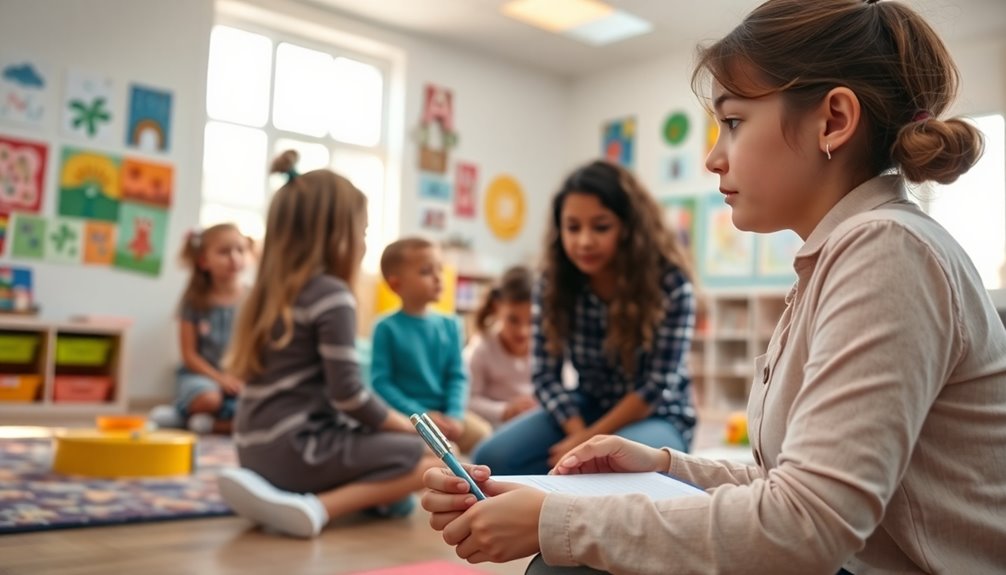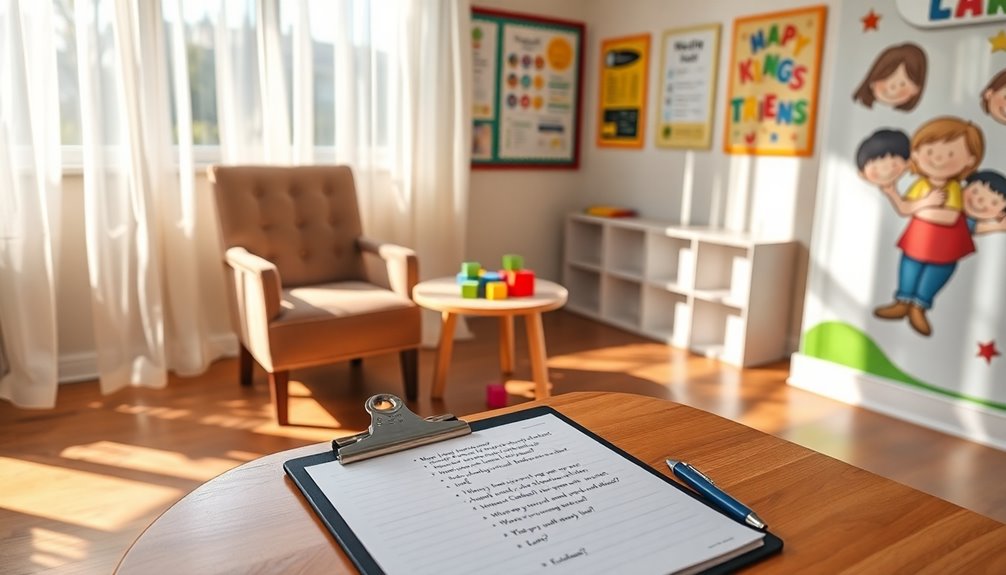When conducting preschool teacher interviews, it's crucial to ask targeted questions to gauge fit. Start by exploring their teaching philosophy; ask how they foster curiosity and creativity in young learners. Inquire about their experiences, like their most rewarding teaching moment or a challenge they've overcome. Don't forget to touch on classroom management strategies—how they set expectations and encourage positive behavior. Engaging with parents is important, so ask how they maintain communication and build relationships. These foundational questions will help you understand their approach and commitment to nurturing young minds. There's plenty more to explore on effective interviewing!
Key Takeaways
- Describe your teaching philosophy and how it aligns with the school's values and commitment to nurturing young learners.
- Share a rewarding teaching moment that inspired you and highlights your passion for education.
- Discuss your classroom management strategies and how you create a positive learning environment for preschoolers.
- Explain how you engage with parents to foster strong relationships and encourage their participation in the classroom.
- Highlight any specialized training or certifications that enhance your teaching skills and adaptability in diverse settings.
General Interview Questions

When preparing for preschool teacher interviews, you'll likely encounter a range of general interview questions designed to assess your personality and attitude.
These questions serve as a warm-up, helping to establish rapport with the interviewer. You might hear prompts like, "Tell me about yourself," or "What motivates you?" Your responses offer insight into your character and how well you might fit into the school's environment.
It's important to express your passion for teaching and your commitment to fostering a positive learning atmosphere. Remember, the goal is to showcase your enthusiasm and willingness to contribute to the educational community.
Approaching these questions with authenticity can set a solid foundation for more detailed inquiries later on.
Experience and Background

Building on your initial responses to general interview questions, the experience and background section allows you to showcase your qualifications and teaching philosophy.
Here, you can highlight your unique journey in education, demonstrating what you bring to the classroom. Consider sharing:
- Your most rewarding teaching moment that inspired you.
- Specific challenges you've overcome that shaped your approach.
- The diverse settings where you've taught, emphasizing adaptability.
- Any specialized training or certifications that enhance your skills.
These experiences not only illustrate your capabilities but also reveal your passion for nurturing young minds.
Teaching Philosophy and Approach

A strong teaching philosophy shapes how you engage with young learners and influences their development. Your beliefs about education guide your approach to teaching, whether it leans towards traditional methods or progressive strategies.
Reflecting on your experiences, consider how you foster curiosity, creativity, and critical thinking in your students. Emphasizing a child-centered approach allows you to adapt to individual needs and learning styles, creating an inclusive environment.
You'll want to articulate how collaboration, exploration, and play are essential in early education. Discuss your flexibility in adjusting methods to guarantee every child thrives.
Ultimately, your philosophy should resonate with the school's values and demonstrate your commitment to nurturing young minds in a supportive atmosphere.
Classroom Management Strategies

Effective classroom management strategies create a foundation for a positive learning environment where students feel safe and engaged.
You'll want to implement techniques that foster respect and cooperation among your students.
Here are four essential strategies:
- Establish Clear Expectations: Let students know what behavior is acceptable from the start.
- Use Positive Reinforcement: Reward good behavior to encourage students to repeat it.
- Implement Consistent Routines: Routines help students feel secure and understand what's coming next.
- Encourage Open Communication: Create an atmosphere where students feel comfortable expressing their thoughts and feelings.
Engaging With Parents

Creating a positive learning environment goes beyond the classroom; it extends to engaging with parents and guardians as well. Regular communication is essential for fostering relationships that support children's development. Use various methods like newsletters, emails, and parent-teacher conferences to keep parents informed and involved. Encourage their participation in classroom activities to strengthen this bond.
| Engagement Method | Purpose |
|---|---|
| Newsletters | Share updates and resources |
| Parent-Teacher Meetings | Discuss child progress and concerns |
| Classroom Events | Foster community and involvement |
Being open to feedback and addressing concerns promptly builds trust. When parents feel valued and included, they become crucial partners in their child's education.
Promoting Cooperative Learning

- Fosters Communication: Kids learn to express their ideas clearly and listen to others.
- Builds Trust: Working together cultivates a sense of belonging and respect among peers.
- Enhances Problem-Solving: Collaborative tasks push students to think critically and creatively.
- Boosts Confidence: Achieving goals as a team helps children feel valued and capable.
Implementing these practices not only enriches the learning experience but also prepares students for future collaborative environments. Additionally, establishing healthy boundaries during group activities can help children learn to respect personal space and autonomy.
Assessing Student Progress

Evaluating student progress is essential for understanding how well each child is grasping the material and what areas may need additional support. You can use various methods to assess progress, including observations, informal assessments, and portfolios. Here's a simple framework to contemplate when evaluating each child's development:
| Assessment Method | Purpose |
|---|---|
| Observations | Track daily interactions |
| Informal Assessments | Gauge understanding in real-time |
| Portfolios | Showcase a child's work over time |
| Checklists | Identify specific skill mastery |
Handling Conflicts

Conflict resolution in the classroom is essential for maintaining a positive learning environment. You need to be prepared to address conflicts quickly and effectively.
Here are some strategies to contemplate:
- Listen actively to both sides of the story, showing empathy and understanding.
- Encourage open communication, allowing children to express their feelings and thoughts.
- Teach problem-solving skills so kids can learn to resolve disputes on their own.
- Set clear behavioral expectations to help prevent conflicts from arising in the first place.
Frequently Asked Questions
How Do You Incorporate Technology Into Your Teaching?
You can incorporate technology into your teaching by using interactive apps and educational games that engage students.
Consider using tablets for storytelling or digital art projects, allowing kids to express creativity. You might also integrate videos to enhance lessons, sparking discussions.
Additionally, using online resources for research can help develop critical thinking skills.
Always guarantee that technology complements your teaching goals and fosters a positive learning environment where students feel comfortable exploring.
What Role Does Play Have in Your Classroom?
Did you know that 90% of a child's brain development occurs by age five?
In your classroom, play is essential for fostering creativity and social skills. You encourage exploration through structured play, allowing children to learn problem-solving and cooperation.
Describe Your Approach to Cultural Diversity in Education
Your approach to cultural diversity in education should embrace inclusivity and respect for all backgrounds.
You can integrate diverse materials and resources into your lessons, celebrating various cultures through stories, music, and activities.
Encourage students to share their own experiences, fostering a sense of belonging.
By creating a classroom environment that values differences, you'll help students develop empathy and understanding, preparing them for a diverse world.
It's all about making everyone feel valued and included.
How Do You Stay Current With Early Childhood Education Trends?
Staying current with early childhood education trends is like catching the wind—constantly shifting and full of surprises.
You can subscribe to reputable journals, attend workshops, and engage in professional networks. Regularly participating in webinars keeps your knowledge fresh and relevant.
Collaborating with other educators also sparks new ideas. By integrating these resources into your routine, you'll not only enhance your teaching practices but also inspire your students with the latest insights in education.
What Are Your Strategies for Fostering Creativity in Students?
To foster creativity in students, you can create an open environment that encourages exploration and imagination.
Use diverse materials, like art supplies and building blocks, to inspire hands-on projects. Incorporate storytelling and role-playing to spark their creativity.
Allow for unstructured playtime, where they can experiment freely.
Finally, celebrate their unique ideas and creations, providing positive feedback that motivates them to think outside the box and express themselves confidently.
Conclusion
As you prepare for your preschool teacher interview, remember that each question is an opportunity to connect your experiences with your teaching philosophy. Coincidentally, your reflections on past challenges and successes can illuminate your passion for nurturing young learners. By sharing your insights and demonstrating your approach, you not only showcase your qualifications but also reveal the heart behind your teaching. Embrace these moments, and you'll create a lasting impression that resonates with your interviewers.
Eugene brings a fresh, dynamic voice to our platform as one of our talented Writers. Specializing in research-driven content, he explores the latest findings in psychology and personal growth, translating them into actionable insights for our readers. Eugene’s work is fueled by a curiosity about what makes us tick and a desire to help others unlock their potential.










